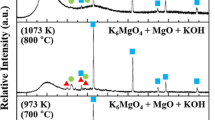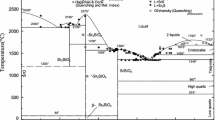Abstract
An optimized set of thermodynamic functions for the K2O-SiO2 system at 105 Pa pressure was obtained by considering available phase diagram and thermodynamic data. KSi0.25O and SiO2 were selected as components for the liquid phase. With respect to these components, the highly non-ideal interactions of potassium oxide and silica could be described by using only three temperature-independent Redlich-Kister coefficients for the excess G of the liquid phase. The result is in good agreement with experimental data.
Similar content being viewed by others
References
F.C. Kracek, N.L. Bowen, and G.W. Morey: “Equilibrium Relations and Factors Influencing Their Determination in the System K2SiO3-SiO2,” J. Phys. Chem., 1937, 41(9), pp. 1183–193.
O. Redlich and A.T. Kister: “Algebraic Representation of Thermodynamic Properties and the Classification of Solutions,” Ind. Eng. Chem., 1948, 40(2), pp. 345–48.
F.C. Kracek: “Contributions of Thermochemical and X-Ray Data to the Problem of Mineral Stability,” Annual Report of the Directorate of the Geophysical Laboratory, Geophysical Laboratory Paper 1215, 1953, pp. 69–75.
C.J.B. Fincham and F.D. Richardson: “The Behaviour of Sulphur in Silicate and Aluminate Melts,” Proc. Roy. Soc., 1954, 223, pp. 40–62.
K.K. Kelley: “Heats and Free Energies of Formation of Anhydrous Silicates,” U.S. Bur. Mines, Rept. Inv. No. 5901, 1962, pp. 1–32.
R.J. Charles: “Metastable Liquid Immiscibility in Alkali Metal Oxide-Silica Systems,” J. Am. Ceram. Soc., 1966, 49(2), pp. 55–62.
Y. Moriya, D.H. Warrington, and R.W. Douglas: “Metastable Liquid-Liquid Immiscibility in Some Binary and Ternary Alkali Silicate Glasses,” Phys. Chem. Glasses, 1967, 8(1), pp. 19–25.
D.R. Stull, D.L. Hildenbrand, F.L. Oetting, and G.C. Sinke: “Low Temperature Heat Capacities of 15 Inorganic Compounds,” J. Chem. Eng. Data, 1970, 15(1), pp. 52–56.
M.G. Frohberg, E. Caune, and M.L. Kapoor: “Measurement of the Activity of the Oxygen Ions in the Liquid Systems Na2O-SiO2 and K2O-SiO2,” Arch. Eisenhüttenwes., 1973, 44(8), pp. 585–88 (in German).
N. Eliezer, R.A. Howald, M. Marinkovic, and I. Eliezer: “Vapor Pressure Measurements, Thermodynamic Parameters, and Phase Diagram for the System Potassium Oxide-Silicon Oxide at High Temperatures,” J. Phys. Chem., 1978, 82(9), pp. 1021–26.
R.P. Beyer, M.J. Ferrante, R.R. Brown, and G.E. Daut: “Thermodynamic Properties of Potassium Metasilicate and Disilicate,” U.S. Bur. Mines, Rept. Inv. No. 8410, 1980, pp. 1–21.
Y. Kawamoto and M. Tomozawa: “Prediction of Immiscibility Boundaries of the Systems K2O-SiO2, K2O-Li2O-SiO2, K2O-N2O-SiO2 and K2O-BaO-SiO2,” J. Am. Ceram. Soc., 1981, 64(5), pp. 289–92.
P. Richet, Y. Bottinga, L. Denielou, J.P. Petitet, and C. Tequi: “Thermodynamic Properties of Quartz, Cristobalite and Amorphous SiO2: Drop Calorimetry Measurements Between 1000 and 1800 K and a Review from 0 to 2000 K,” Geochim. Cosmochim. Acta, 1982, 46, pp. 2639–58.
M. Hillert, B. Jansson, B. Sundman, and J. Ågren: “A Two-Sublattice Model for Molten Solutions with Different Tendency for Ionization,” Metall. Trans. A, 1985, 16A, pp. 261–66.
JANAF Thermochemical Tables, 3rd ed., J. Phys. Chem. Ref. Data, 1985, 14(S1–2), pp. 1–1856.
P. Richet and Y. Bottinga: “Heat Capacity of Aluminium-Free Liquid Silicates,” Geochim. Cosmochim. Acta, 1985, 49, pp. 471–86.
A.D. Pelton and M. Blander: “Thermodynamic Analysis of Ordered Liquid Solutions by a Modified Quasichemical Approach-Application to Silicate Slags,” Metall. Trans. B, 1986, 17B, pp. 805–15.
I. Barin: Thermochemical Data of Pure Substances, VCH Verlagsgesellschaft, Weinheim, Germany, 1989.
G. Eriksson and K. Hack: “ChemSage—A Computer Program for the Calculation of Complex Chemical Equilibria,” Metall. Trans. A, 1990, 21B, pp. 1013–23.
M. Hillert, B. Jansson, and B. Sundman: “A Model for Silicate Melts,” Metall. Trans. B, 1990, 21B, pp. 404–06.
S.S. Kim and T.H. Sanders: “Thermodynamic Modeling of Phase Diagrams in Binary Alkali Silicate Systems,” J. Am. Ceram. Soc., 1991, 74(8), pp. 1833–40.
P. Wu, G. Eriksson, and A.D. Pelton: “Optimization of the Thermodynamic Properties and Phase Diagrams of the Na2O-SiO2 and K2O-SiO2 Systems,” J. Am. Ceram. Soc., 1993, 76(8), pp. 2059–64.
A. Nordin: “Chemical Elemental Characteristics of Biomass Fuels,” Biomass Bioenergy, 1994, 6(5), pp. 339–47.
E. Königsberger and G. Eriksson: “A New Optimization Routine for ChemSage,” Calphad, 1995, 19(2), pp. 207–14.
Author information
Authors and Affiliations
Rights and permissions
About this article
Cite this article
Forsberg, S. Optimization of thermodynamic properties of the K2O-SiO2 system at high temperatures. JPE 23, 211 (2002). https://doi.org/10.1361/105497102770331695
Received:
Revised:
DOI: https://doi.org/10.1361/105497102770331695




